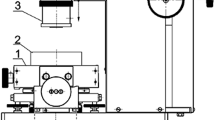Abstract
The paper gives the analytical solution to the one dimensional hyperbolic heat conduction equation in an insulated slab-shaped sample that is heated uniformly on the front face with δ or laser impulse. The solution results in a formula that enables to estimate the minimum mean free path of energy carriers in the sample to detect the second sound (i.e. the thermal wave) at the sample rear face. A method of experimental data evaluation at the second sound effect is proposed, which gives the thermal diffusivity of the sample and the parameters of heat propagation.



















Similar content being viewed by others
Abbreviations
- a :
-
thermal diffusivity
- b :
-
dimensionless parameter
- c :
-
specific heat capacity
- c v :
-
specific heat capacity per volume unit
- I0 (x), I1 (x):
-
modified Bessel functions of the first kind
- L :
-
sample thickness
- L c :
-
sample critical thickness
- ℓ:
-
mean free path
- ℓmin :
-
minimum mean free path
- Q :
-
total delivered energy per square meter
- Q w :
-
total energy of the wave per square meter
- \({\bar{Q}}_{w}\) :
-
total relative energy of the wave per square meter
- q :
-
density of energy flow rate
- T :
-
temperature
- \({\bar{T}}\) :
-
relative temperature
- T ∞ :
-
resultant temperature
- t :
-
time
- t*:
-
wave transit time
- \({\bar{t}}\) :
-
dimensionless time
- t T :
-
duration of the impulse
- \({\bar{t}}_{T}\) :
-
relative duration of the impulse
- t c :
-
characteristic time of the impulse
- \({\bar{t}}_{c}\) :
-
relative characteristic time of the impulse
- v :
-
mean velocity of heat carriers in substance
- x :
-
coordinate
- \({\bar{x}}\) :
-
dimensionless coordinate
- δ(x):
-
delta-function
- μ (x):
-
unit-step function
- λ:
-
thermal conductivity
- ρ:
-
mass density
- τ:
-
relaxation time
- ω:
-
wave velocity
References
Ackerman CC, Bertman B, Fairbank HA, Guyer RA (1966) Second sound in solid helium. Phys Rev Lett 16:789–791
Mc Nelly TF, Rogers SJ, Channin DJ, Rollefson RJ, Goubau WM, Schmidt GE, Krumhansl JA, Pohl RO (1970) Heat pulses in NaF: onset of second sound. Phys Rev Lett 24:102–102
Chester M (1963) Second sound in solids. Phys Rev 131:2013–2015
Gembarovič J, Majerník V (1987) Determination of thermal parameters of relaxation materials. Int J Heat Mass Transfer 30:199–201
Gembarovič J, Majerník V (1988) Non-Fourier propagation of heat pulses in finite medium. Int J Heat Mass Transfer 31:1073–1080
Chen HT, Lin JY (1993) Numerical analysis for hyperbolic heat conduction. Int J Heat Mass Transfer 36:2891–2898
Vedavarz A, Mitra K, Kumar S (1994) Hyperbolic temperature profiles for laser surface interactions. J Appl Phys 76:5014– 5021
Tang DW, Araki N (1996) Analytical solution of non-Fourier temperature response in a finite medium under laser-pulse heating. Heat Mass Transfer 31:359–363
Mitra K, Kumar S, Vedavarz A (1996) Parametric aspects of electron–phonon temperature model for short pulse laser interactions with thin metallic films. J Appl Phys 80:675–680
Tang DW, Araki N (1999) Wavy, wavelike, diffusive thermal responses of finite rigid slabs to high-speed heating of laser pulses. Int J Heat Mass Transfer 42:855–860
Abdel-Hamid B (1999) Modelling non-Fourier heat conduction with periodic thermal oscillation using the finite integral transform. Appl Math Model 23:899–914
Kiwan S, Al-Nimr M, A1-Sharo’a M (2000) Trial solution methods to solve the hyperbolic heat conduction equation. Int Comm Heat Mass Transfer 27:865–876
Chen HT, Peng SY, Yang PC, Fang LC (2001) Numerical method for hyperbolic inverse heat conduction problems. Int Comm Heat Mass Transfer 28:847–856
Lewandowska M, Malinowsky L (2001) Hyperbolic heat conduction in the semi-infinite body with a time-dependent laser heat source. Heat Mass Transfer 37:333–342
Lewandowska M, Malinowsky L (2002) Thermal wave propagation due to localised heat inputs—the Laplace transforms method analysis. Heat Mass Transfer 38:459–466
Haji-Sheikh A, Minkowycz WJ, Sparrow EM (2002) Certain anomalies in the analysis of hyperbolic heat conduction. J Heat Transfer 124:307–319
Píšek F, Jeníček L, Ryš P (1968) Nauka o materiálu 1, Vlastnosti kovů, 2nd edn. Academie, Praha
Dekker AJ (1966) Fyzika pevných latok. Academie, Praha
Hartmanová M, Trnovcová V (1978) Iónové kryštály. Alfa, Bratislava
Jánoš S (1980) Fyzika nízkych teplôt. ALFA, Bratislava
Ascroft NW, Mermin ND (1976) Solid state physics. Saunders College, Philadelphia
Krempaský J (1988) Fyzika 2nd edn. Alfa, Bratislava
Bertman B, Sandifod DJ (1970) Second sound in solid helium. Sci Am 222:92–101
Kaminski W (1990) Hyperbolic heat conduction for materials with a non-homogeneous inner structure. J Heat Transfer 112:555–560
Zauderer E (1989) Partial differential equations, 2nd edn. Wiley, New York
Arsenin J (1977) Matematická fyzika. ALFA, Bratislava
Parker WJ, Jenkins RJ, Butler CP, Abbott GL (1961) Flash method of determining thermal diffusivity, heat capacity, and thermal conductivity. J Appl Phys 32:1679–1684
Klimenko MM, Krizanovski RE, Sherman VE (1979) Impulznyj metod opredelenia temperaturoprovodnosti. Teplofizika Vysokich Temperature 17:1216
Andrews LC (1992) Special functions of mathematics and engineers, 2nd edn. McGraw-Hill, New York
Larson KB, Koyama K (1967) Correction for finite-pulse-time effects in very thin samples using the flash method of measuring thermal diffusivity. J Appl Phys 38:465–474
Maglić KD, Taylor RE (1992) The apparatus for thermal diffusivity measurement by the laser pulse method. In: Compendium of thermophysical property measurement methods, vol 2. Plenum Publishing, New York, p 281
Author information
Authors and Affiliations
Corresponding author
Rights and permissions
About this article
Cite this article
Beňačka, J. On hyperbolic heat conduction in solids: minimum mean free path of energy carriers and a method of estimating thermal diffusivity and heat propagation characteristics. Heat Mass Transfer 44, 873–887 (2008). https://doi.org/10.1007/s00231-007-0289-9
Received:
Accepted:
Published:
Issue Date:
DOI: https://doi.org/10.1007/s00231-007-0289-9




